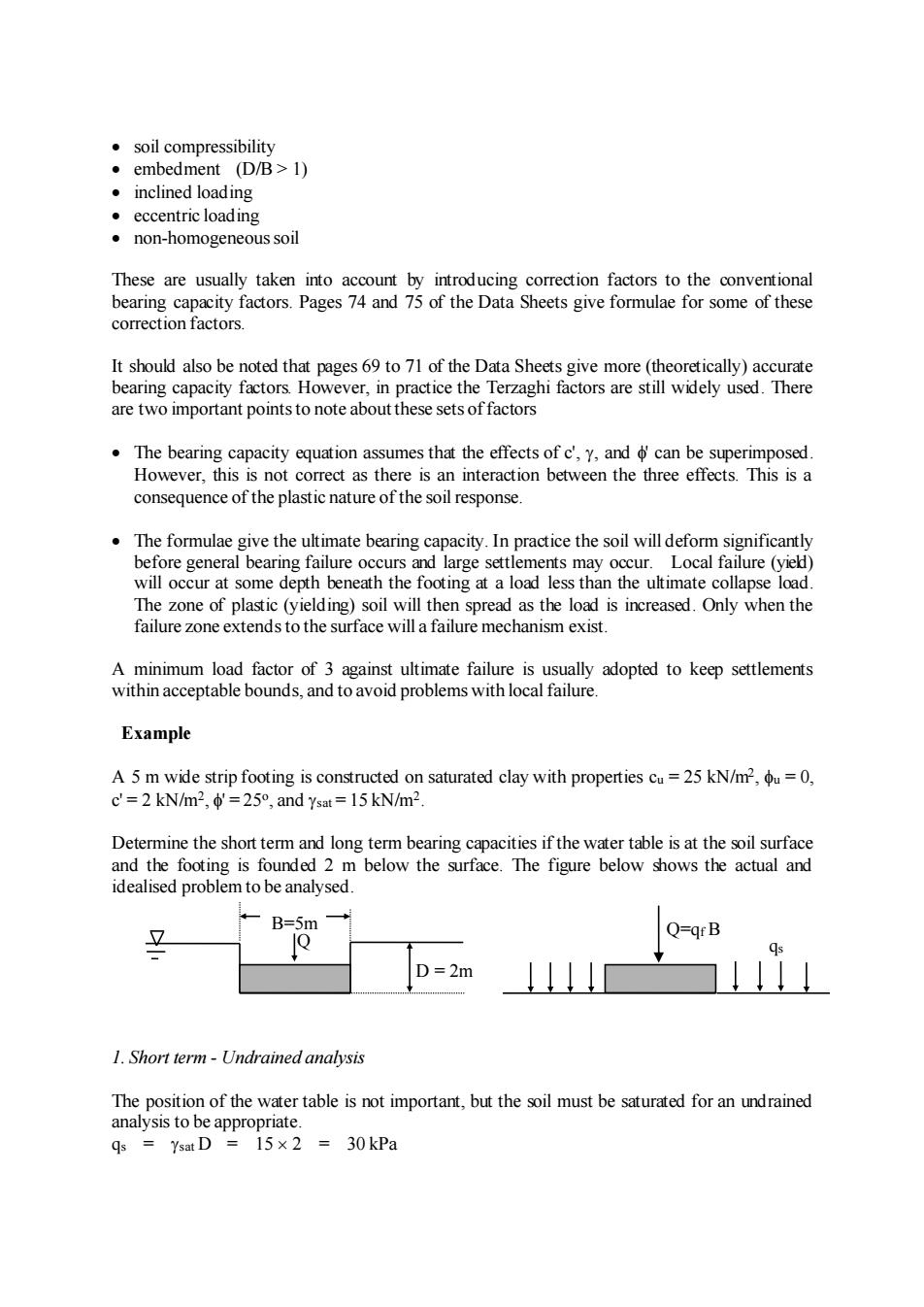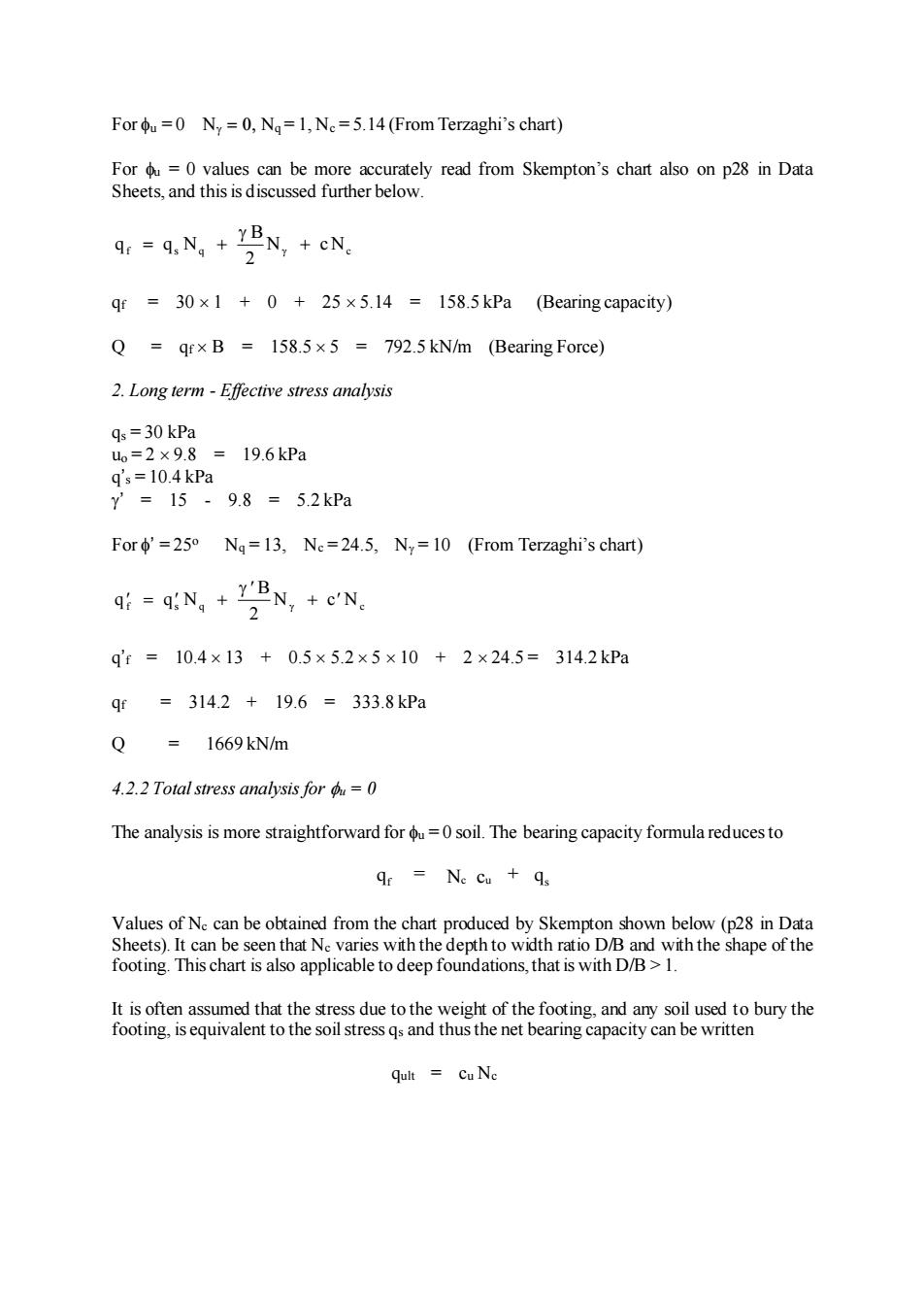
soil compressibility embed ment (D/B>1) 。inclined loading eccer load 。 non-homogeneous soil These are usually taken into account by introducing correction factors to the conventional hearing capacity factors.Pages 74 and 75 of the Data Sheets give formulae for some of these correction factors. It should also be noted that pages 69 to 71 of the Data Sheets give more(theoretically)accurate bearing capacity factors However,in practice the Terzaghi factors are still widely used.There are two important points to note about these sets of factors The bearing capacity equation assumes that the effects of c',Y,and can be superimposed. However,this is not correct as there is an interaction between the three effects.This is a consequence of the plastic nature of the soil response. .The formulae give the ultimate bearing capacity.In practice the soil will deform significantly s m Local (yed 30 e aep ing at a oad le then sprea as the loa s increase d.Only when the echanism exis adopted to keep settlements avoid prob ms with local failure Example A 5 m wide strip footing is constructed on saturated clay with properties cu=25 kN/m2,=0, c'=2 kN/m2 =25 and ysat=15 kN/m2 Determine the short term and long term bearing capacities if the water table is at the soil surface and the footing is founded 2 m below the surface.The figure below shows the actual and idealised problem to be analysed. Q=qrB D=2m 1.Short term-Undrained analysis The position of the water table is not important,but the soil must be saturated for an undrained analysis to be app qs=Ysat D=15×2=30kPa
• soil compressibility • embedment (D/B > 1) • inclined loading • eccentric loading • non-homogeneous soil These are usually taken into account by introducing correction factors to the conventional bearing capacity factors. Pages 74 and 75 of the Data Sheets give formulae for some of these correction factors. It should also be noted that pages 69 to 71 of the Data Sheets give more (theoretically) accurate bearing capacity factors. However, in practice the Terzaghi factors are still widely used. There are two important points to note about these sets of factors • The bearing capacity equation assumes that the effects of c', , and ' can be superimposed. However, this is not correct as there is an interaction between the three effects. This is a consequence of the plastic nature of the soil response. • The formulae give the ultimate bearing capacity. In practice the soil will deform significantly before general bearing failure occurs and large settlements may occur. Local failure (yield) will occur at some depth beneath the footing at a load less than the ultimate collapse load. The zone of plastic (yielding) soil will then spread as the load is increased. Only when the failure zone extends to the surface will a failure mechanism exist. A minimum load factor of 3 against ultimate failure is usually adopted to keep settlements within acceptable bounds, and to avoid problems with local failure. Example A 5 m wide strip footing is constructed on saturated clay with properties cu = 25 kN/m2 , u = 0, c' = 2 kN/m2 , ' = 25o , and sat = 15 kN/m2 . Determine the short term and long term bearing capacities if the water table is at the soil surface and the footing is founded 2 m below the surface. The figure below shows the actual and idealised problem to be analysed. 1. Short term - Undrained analysis The position of the water table is not important, but the soil must be saturated for an undrained analysis to be appropriate. qs = sat D = 15 2 = 30 kPa qs D = 2m B=5m Q Q=qf B

Foru=0 Ny=0,N=1,Ne=5.14 (From Terzaghi's chart) For=0 values can be more accurately read from Skempton's chart also on p28 in Data Sheets,and this is discussed further below. 4r g.N,T,+eN. qr =30x1 +0+25x5.14 =158.5kPa (Bearingcapacity) Q qrx B 158.5x5 792.5 kN/m (Bearing Force) 2.Long term-Effective stress analysis qs=30kPa =2×9.8=19.6kPa q's=10.4 kPa y=15-9.8=5.2kPa For'=250 Ng=13,Ne=24.5,N=10 (From Terzaghi's chart) iNN,e'N, qr=10.4×13+0.5×5.2x5×10+2×24.5=314.2kPa qf=314.2+19.6=333.8kPa Q =1669kN/m 4.2.2 Total stress analysis for=0 The analysis is more straightforward for=0soil.The bearing capacity formula reduces to gr Ne cu qs Values of Ne can be obtained from the chart produced by Skempton shown below(p28 in Data Sheets).It can be seen that Ne varies with the depth to width ratio D/B and with the shape of the footing.This chart is also applicable to deep foundations,that is with D/B>1. It is often assumed that the stress due to the weight of the footing.and any soil used to bury the footing,is equivalent to the soil stress qs and thus the net bearing capacity can be written qult Cu Ne
For u = 0 N = q = 1, Nc = 5.14 (From Terzaghi’s chart) For u = 0 values can be more accurately read from Skempton’s chart also on p28 in Data Sheets, and this is discussed further below. q q N B f = s q + N + cNc 2 qf = 30 1 + 0 + 25 5.14 = 158.5 kPa (Bearing capacity) Q = qf B = 158.5 5 = 792.5 kN/m (Bearing Force) 2. Long term - Effective stress analysis qs = 30 kPa uo = 2 9.8 = 19.6 kPa q’s = 10.4 kPa ’ = 15 - 9.8 = 5.2 kPa For ’ = 25o Nq = 13, Nc = 24.5, N = 10 (From Terzaghi’s chart) = + q q N + B f s q N c Nc 2 q’f = 10.4 13 + 0.5 5.2 5 10 + 2 24.5 = 314.2 kPa qf = 314.2 + 19.6 = 333.8 kPa Q = 1669 kN/m 4.2.2 Total stress analysis for u = 0 The analysis is more straightforward for u = 0 soil. The bearing capacity formula reduces to Values of Nc can be obtained from the chart produced by Skempton shown below (p28 in Data Sheets). It can be seen that Nc varies with the depth to width ratio D/B and with the shape of the footing. This chart is also applicable to deep foundations, that is with D/B > 1. It is often assumed that the stress due to the weight of the footing, and any soil used to bury the footing, is equivalent to the soil stress qs and thus the net bearing capacity can be written qult = cu Nc f c u s q = N c + q